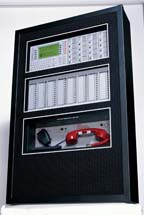Less ‘Taxing’ Fire System

That’s exactly what the fire alarm system installed at the Internal Revenue Service Building in Farmers Branch, Texas, was intended to do. And for years it did the job admirably. Still, in keeping with the theme of protecting taxes and the people who collect them, it was decided that even “admirably” was not quite enough. After all, the facility, built in 1984 and staffed with 1,100 employees in the building’s 322,000 square feet, had far too critical a mission – and far too many human assets – for management to miss an opportunity to improve safety. Consequently, it was decided that the system would receive a comprehensive upgrade.

Fire upgrade
The General Services Administration, which ultimately would purchase the new system, turned to Carl Ball, president of Fire Systems Design, a NESCO affiliate in Dallas/Fort Worth area. Ball in turn recommended the AM2020, produced by Notifier of Northford, Conn., as the foundation of the upgrade.
With the system firmly in place, Ball then recommended the same company’s XPIQ Quad Intelligent Audio Transponder, an advanced voice evacuation system. Accompanying the XPIQ was firefighter phones, FCPS remote power supplies for visual alarms (strobes), addressable devices, detectors and pulls stations.
The integrated, multi-channel distributed audio amplification subsystem would be remotely controlled by a fire alarm control panel through a signaling line circuit. By using a software program and internal switching capabilities, it could eliminate the need for relays and complex wiring during installation, and would be compatible with the company’s complete line of voice evacuation intelligent fire alarm panels (in this case, the existing 2020 system). As a result, the XPIQ would handle all the switching easily with less wiring.
To Betty Doss, senior support service specialist and the IRS building’s on-site facility manager, the minimal wiring was a huge plus. “Because each floor has an individual transponder, there are very few cables,” she said. “Thus, there were fewer wires to be pulled through the entire building, which obviously means less potential damage to the building’s infrastructure. As a facility manager, this made me very confident in the installation.”
Addressable advantages
Being addressable means that the system is taking preventative measures by informing the user of sensitivity levels on an individual detector basis. More importantly, it also means that the exact location of trouble can be identified.“The fact that the system can point out the exact device that is in trouble, so that it is easily found, is a tremendous benefit,” said Facility Director Fred Oeltjendiers. “Traditional systems can point out the zone where the trouble is located, but not the exact location. The time savings, which may be only a matter of seconds, can make all the difference in a life-threatening emergency.”
In addition, every occupant of the building can hear and see an alarm, thanks to the voice messages and strobe lights. The old system was limited in that it was not audible throughout the building. Now, for example, if there is an emergency on floor five of the 15-floor building, people on floors one through four and six through 15 will also be informed of the event.
The growth potential of the system should not be underestimated, either. “The IRS needed a system that would be flexible enough to grow with the building, to meet code changes and upgrades,” said Ball. “The system has built-in spare capacity” and migration capability.
Besides the fire protection and alarm, the new system also offers capabilities for other emergency warnings, such as weather warnings. A tornado warning, for example, will send people to a designated area – no small benefit in a state like Texas where tornadoes are not an uncommon occurrence. Plus, the system can offer two separate channels of voice; consequently, it can relay two different messages.
Oeltjendiers had high praise for Fire Systems Design’s performance during the implementation. “Fire Systems Design did a fantastic job,” he said. “They were very sensitive to the security demands, and completed all work after hours. Each test went according to spec, and the system has performed extremely well.”
But technology and performance aside, it is the building occupants’ feeling of security that truly tells the story of the system’s performance.
“If there is trouble, everyone can now hear and see the alarm in the entire building,” Doss said. “This goes a long way towards making our tenants feel more secure.”
For More Information:
Information on Notifier of Northford, Conn., is at www.notifier.com or go to the Security magazine Web site at www.securitymagazine.com and access the online Buyers Guide for fire safety and integrated systems sources. There are is Security's LINX service, powered by Google, to find other articles on addressables.Looking for a reprint of this article?
From high-res PDFs to custom plaques, order your copy today!




